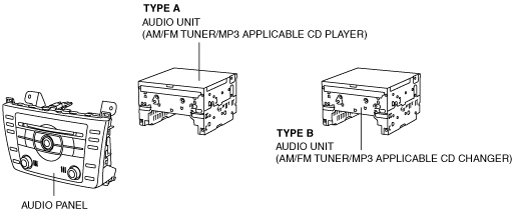 |
AUDIO UNIT CONSTRUCTION/OPERATION
id092000101600
Structural view
am6zzn00000530
|
Terminal Layout and Signal
|
Terminal |
Signal |
|
|---|---|---|
 |
1A
|
Front door speaker LH (+)
|
|
1B
|
B+
|
|
|
1C
|
Front door speaker LH (–)
|
|
|
1D
|
Front door speaker RH (+)
|
|
|
1E
|
TNS (+)
|
|
|
1F
|
Front door speaker RH (–)
|
|
|
1G
|
Illumination (–)
|
|
|
1H
|
Antenna control (5HB/WGN)
|
|
|
1I
|
—
|
|
|
1J
|
AMP control*
|
|
|
1K
|
—
|
|
|
1L
|
—
|
|
|
1M
|
—
|
|
|
1N
|
Steering switch 1
|
|
|
1O
|
CAN_H
|
|
|
1P
|
Steering switch 2
|
|
|
1Q
|
CAN_L
|
|
|
1R
|
ACC
|
|
|
1S
|
Rear door speaker LH (+)
|
|
|
1T
|
AudioPilot® 2*
|
|
|
1U
|
Rear door speaker LH (–)
|
|
|
1V
|
Rear door speaker RH (+)
|
|
|
1W
|
Power ground
|
|
|
1X
|
Rear door speaker RH (–)
|
|
|
Terminal |
Signal |
|
|---|---|---|
 |
2A
|
Power ground
|
|
2B
|
TEL (+)*
|
|
|
2C
|
Input signal RH (+)
|
|
|
2D
|
—
|
|
|
2E
|
Input signal LH (+)
|
|
|
2F
|
—
|
|
|
2G
|
Signal ground
|
|
|
2H
|
—
|
|
|
2I
|
—
|
|
|
2J
|
TEL (–)*
|
|
|
2K
|
—
|
|
|
2L
|
—
|
|
|
2M
|
AUX control
|
|
|
2N
|
—
|
|
|
2O
|
—
|
|
|
2P
|
—
|
|
Switch Location
am6zzn00000531
|
|
|
With RDS (radio data system) |
Without RDS (radio data system) |
|---|---|---|
|
1
|
TRACK/SEEK (up)/H switch
|
FOLDER/DISC* switch (up)
|
|
2
|
TRACK/SEEK (down)/M switch
|
FOLDER/DISC* switch (down)
|
|
3
|
LOAD switch
|
LOAD switch
|
|
4
|
Preset switch “1”
|
Preset switch “1”
|
|
5
|
Preset switch “2”
|
Preset switch “2”
|
|
6
|
FM switch
|
FM switch
|
|
7
|
MEDIA switch
|
MEDIA switch
|
|
8
|
AM switch
|
AM switch
|
|
9
|
Preset switch “4”
|
Preset switch “4”
|
|
10
|
Preset switch “5”
|
Preset switch “5”
|
|
11
|
EJECT switch
|
EJECT switch
|
|
12
|
FOLDER/DISC* switch (up)
|
TRACK/SEEK (up)/H switch
|
|
13
|
FOLDER/DISC* switch (down)
|
TRACK/SEEK (down)/M switch
|
|
14
|
REVERSE/PTY switch
|
DISPLAY switch
|
|
15
|
Preset switch “3”/FAST-FORWARD switch
|
Preset switch “3”
|
|
16
|
CD switch
|
CD switch
|
|
17
|
TA switch
|
CLOCK switch
|
|
18
|
Preset switch “6”
|
Preset switch “6”/REVERSE switch
|
|
19
|
DISPLAY switch
|
FAST-FORWARD switch
|
|
20
|
AUTO MEMORY/12/24h switch
|
RANDOM switch
|
|
21
|
CLOCK switch
|
REPEAT switch
|
|
22
|
POWER/VOLUME switch
|
TUNE/TEXT/AUDIO CONT switch
|
|
23
|
TUNE/TEXT/AUDIO CONT switch
|
POWER/VOLUME switch
|
|
24
|
RANDOM switch
|
AUTO MEMORY/00 switch
|
|
25
|
REPEAT switch
|
SCAN switch
|
CF-Net (Cross Functional-Network)
Outline
1. The CF-Net (Cross Functional-Network) is a function which performs adjustments and settings using the steering switches to adjust/set the audio unit, climate control unit, and the drive information system.
am6zzn00000565
|
2. The CF-Net (Cross Functional-Network) operation is displayed in the information display.
am6zzn00000566
|
3. The items which can be operated by CF-Net (Cross Functional-Network) are as follows:
|
Audio unit
|
Audio volume can be adjusted.
|
|
Audio power supply ON/OFF can be set.
|
|
|
Audio mode can be selected.
(FM1→FM2→AM→CD or CD changer→AUX→OFF)
|
|
|
Each type of setting for each mode can be made.
• Radio
• CD
|
|
|
Climate control unit
|
Climate control temperature can be set.
|
|
Climate control air vent switching can be done.
|
|
|
Climate control airflow volume can be adjusted.
|
|
|
Drive information system
(instrument cluster)
|
Drive information is displayed.
(Time→Average speed→remaining travel distance→Momentary fuel mileage→Speed alarm set speed)
|
|
The speed at which the speed alarm activates the buzzer can be set.
|
Construction/operation
1. An operation signal is input to the audio unit when the steering switches are operated. The audio unit initiates each control based on the input signal.
am6zzn00000567
|
am6zzn00000568
|
am6zzn00000569
|
Action illumination
1. The action illumination is linked to the audio switch operation during TNS ON to turn the audio panel illumination on and off.
2. The target operations of the action illumination are as follows:
Structural view
am6zzn00000585
|
Welcome mode
Outline
1. The welcome mode is linked to the instrument cluster, information display, audio unit, climate control unit to provide a presentation while in the vehicle using illumination and sound effects. Sound effects can be turned on or off by the user.
am6zzn00000578
|
2. When the audio unit detects a welcome mode control signal from the instrument cluster, control of the welcome mode is initiated.
am6zzn00000586
|
Operation